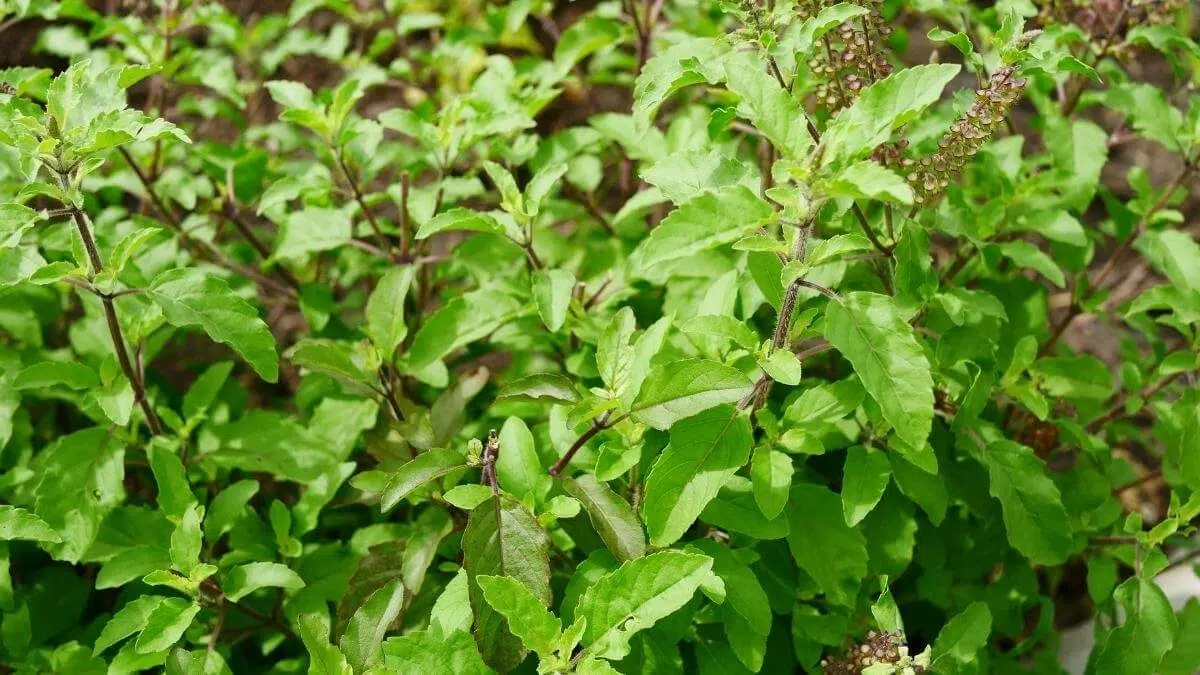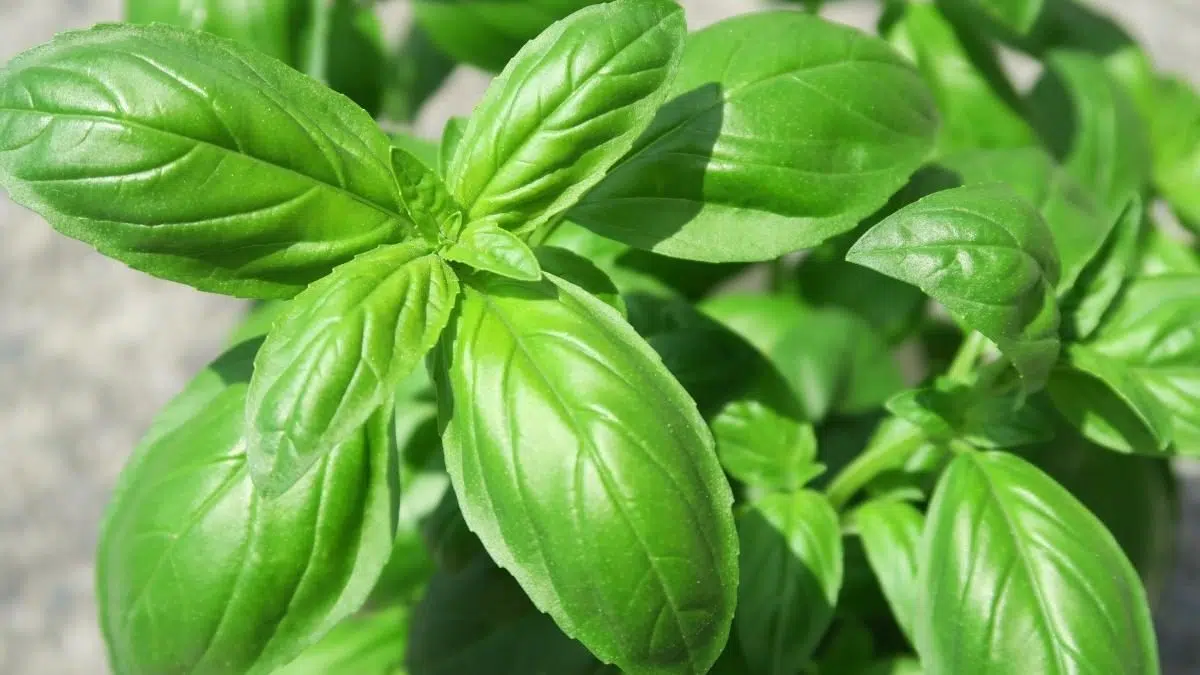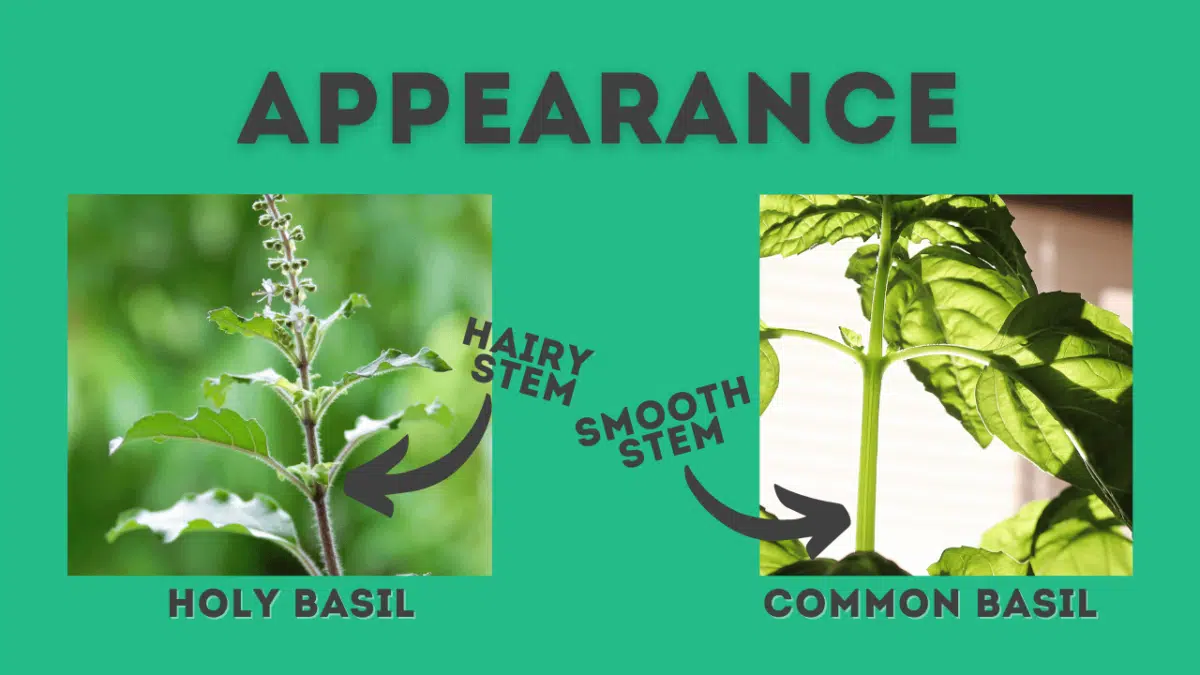Holy basil is a plant in the same family as mint and has a lot of the same medicinal properties. It is also an important part of Indian cooking because it adds flavor to dishes.
Common or sweet basil’s leaves are a lighter shade of green, have deep parallel veins, and grow in bushy clumps rather than spreading outwards as holy basil does.
There are many varieties of basil which makes it easy to get them mixed up, so let’s talk about the differences between holy basil and regular basil since they look so similar.
Holy Basil

Scientific Name: O. tenuiflorum or sanctum
Also Called: Tulsi, Kapoor Tulsi, Temperate Tulsi, Sacred Basil
Background: Holy basil is the sacred basil for Hindus, and is used in both their cooking and for making medicine. The leaves of holy basil were buried with the dead in India to help them get into heaven.
How to Identify: Holy basil grows with purple stems that are hairy (as opposed to common basil which doesn’t have much hair on the stems).
Holy basil looks like a smaller version of common basil with more delicate leaves that are light green on top and deep purple underneath.
Types: While holy basil is just one of the many varieties of basil itself, there are even a few subcategories of holy basil.
- Kapoor – Kapoor is the easiest to grow because it does well in so many different climates
- Rama – Has the most medicinal uses
- Amrita – Amrita has the highest concentration of rosmarinic acid which is said to help with anxiety.
- Krishna – this variety is well known for its medicinal properties
- Vana – is the tallest growing of these holy basil varieties
Taste: Holy basil has a flavor similar to cloves and licorice. It almost tastes like common basil does when you let it flower and start going to seed, which can be a putting-off taste for people and is likely why it’s not commonly used in cooking.
Uses: Holy basil is commonly used for medicinal purposes and holy basil tea because it has a lot of health benefits. Many people use the holy basil plant to help them with sleep, anxiety, blood sugar, and other healing properties.
Common or Sweet Basil

Scientific Name: Ocimum basilicum
Also Called: Sweet basil
Background: Basil is a member of the mint family, and has been used around since at least the 14th century.
How to Identify: Bright green leaves with smooth stems
Taste: Basil is a pungent herb that kind of tastes like mint and anise, but it’s also hard to identify those flavors as you’re eating it. In short, basil is delicious 🙂
Uses: Wide variety of culinary uses as well as having medicinal properties.
Holy Basil vs Common Basil Differences
You may have heard of “tulsi” which is the ayurvedic name for holy basil, so if you were wondering, Tulsi and holy basil are the same thing.
Taste
Holy basil differs in taste from common or sweet basil and tastes much more like licorice or cloves than sweet basil does. Because of this flavor profile, holy basil is not used in cooking as much as sweet or Italian basil is.
Identification & Appearance
If the leaves are still on the plant, holy basil can be easier to tell apart as its stems are hairy, instead of smooth like sweet basil.

While the stems are the clear giveaway between the two, if you only have basil leaves it can be hard to decern the two.
Holy basil has more jagged edges to the leaves, while sweet basil is more rounded and smooth. But Genovese basil is also a common variety and they also have more jagged leaves.
If the stems of the leaves are more purple, it’s likely to be holy basil. If the entire leaf is purple, you’re probably looking at opal basil.
What Are They Used For?
Both sweet basil and holy basil have what’s called “cineole” which is means it has antibacterial, antiseptic, and antifungal properties to them. This is why these 2 varieties are both used for their medicinal benefits.
In the kitchen, you can use either holy basil or sweet basil, but keep in mind they have different flavor profiles. Holy basil has more of a licorice or spicy flavor, while sweet basil tastes more like anise.
Can You Replace Holy Basil with Regular Basil?
While you can substitute sweet or Italian basil in place of holy basil, I wouldn’t recommend going the other way.
The flavors in holy basil are so drastically different from sweet basil, that using it in pesto or other dishes can essentially leave you with something that tastes nothing like what you were trying to create.
Using Holy Basil in the Kitchen
While holy basil isn’t commonly used in cooking, there are quite a few recipes you can use it for.
- Chicken Holy Basil
- Pad Kra Pao (Holy basil stir fry)
- Holy basil tea
- Holy basil-infused olive oil
Where to Buy Holy Basil
It can be a challenge to find specific varieties of basil, especially if you want to get seedlings or plant starts. While sweet basil is one of the most common types you can find in stores, it can be challenging to find fresh holy basil or seedlings.
Starting holy basil from seed is going to give you the most flexibility in terms of how many plants you can grow, the time of year they can be grown.
There are plenty of places to find holy basil and other varieties of basil seeds. Here are a few reliable options:
Is Holy Basil Better Than Regular Basil?
Neither basil is “better” than the other, it just comes down to your personal taste and what you’re looking to use basil for. If you want to use basil in pesto or Italian dishes, sweet basil is likely going to be the right choice.
If you are looking to take advantage of its health benefits, holy basil might be more up your alley.
Does Holy Basil Smell Like Basil?
Holy Basil, or Tulsi, has a more bitter-type scent than sweet basil does, making it great for use in an herbal tea with some lemon and mint.
Should You Use Holy Basil or Regular Basil?
Both holy basil and sweet basil have plenty of uses. Sweet basil is more commonly used in the kitchen, but both varieties will do well in the garden as basil is a great companion plant. The strong scent of basil is great for repelling pests that harm other plants, and it’s beautiful flowers can attract beneficial insects to your garden as well.
Both varieties are easy to grow and maintain, so if you have extra space I would definitely recommend growing your own next season!



This is a very interesting and informative post. Thank you for taking the time to write it.
Very clear and descriptive which will help me with the difference in the future! Thank you!
I learned alot about basil this is the perfect article. Thank you
Thanks…it was well written and very informative.